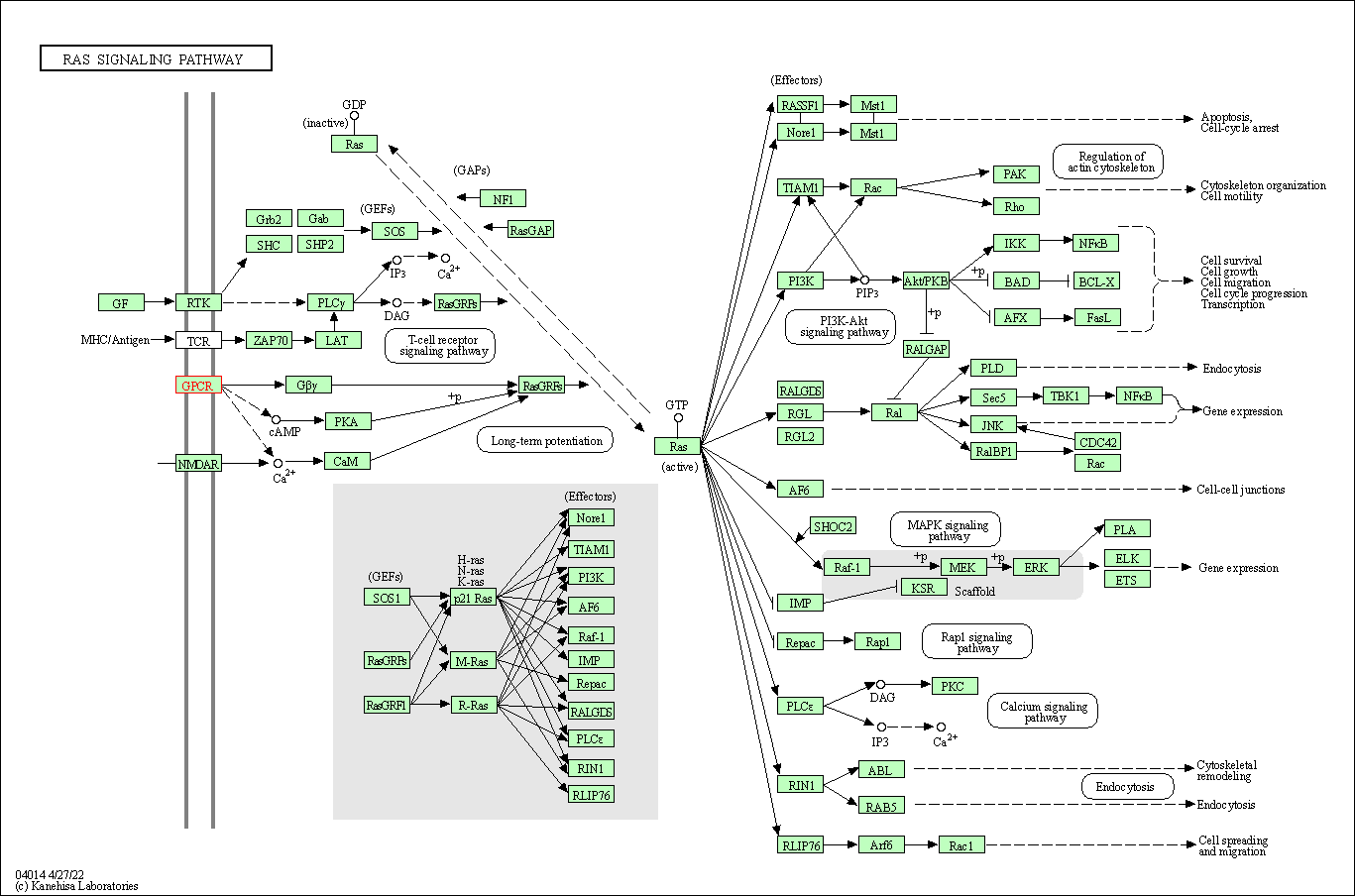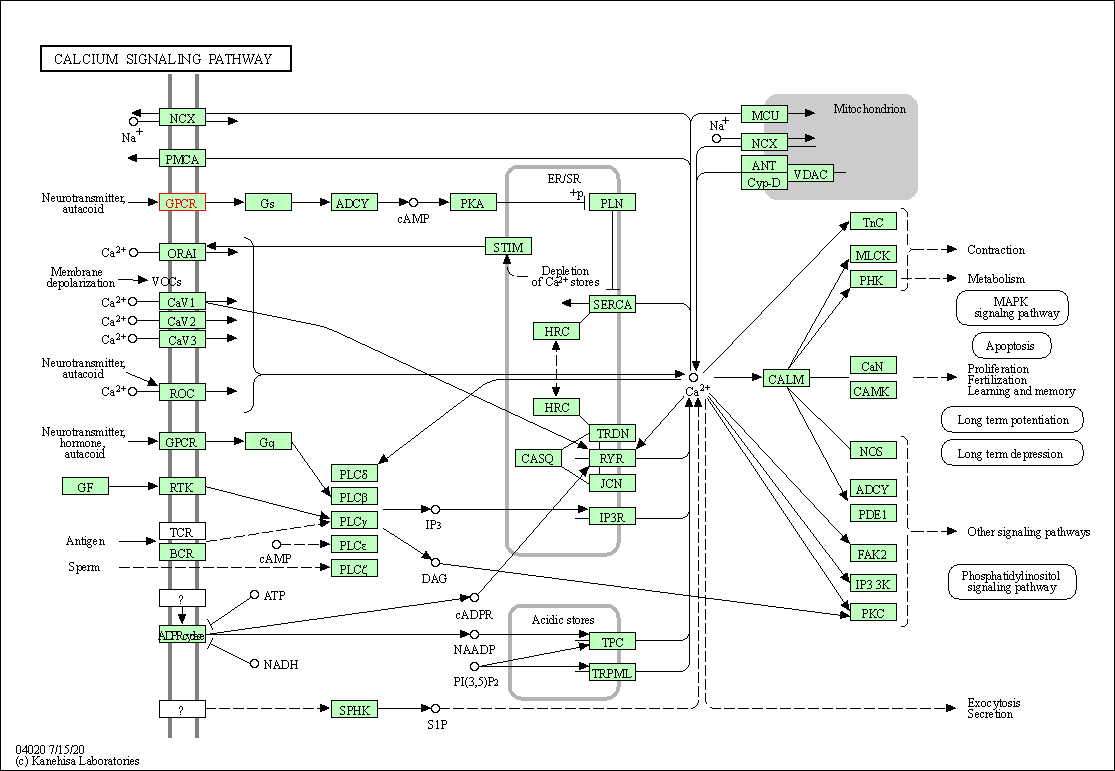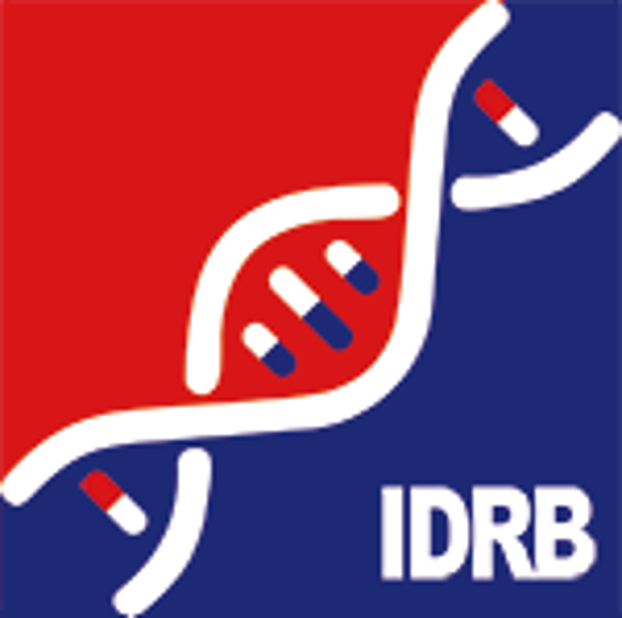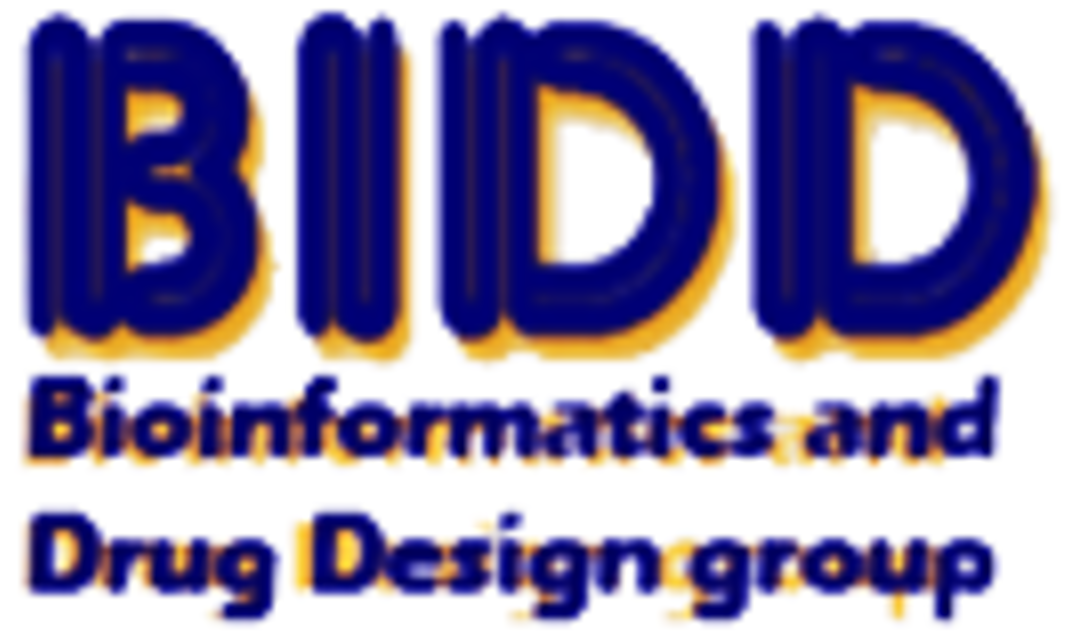Target Information
| Target General Information | Top | |||||
|---|---|---|---|---|---|---|
| Target ID |
T79062
(Former ID: TTDR00157)
|
|||||
| Target Name |
5-HT 7 receptor (HTR7)
|
|||||
| Synonyms |
Serotonin receptor 7; 5HT7; 5-hydroxytryptamine receptor 7; 5-HT7 receptor; 5-HT7; 5-HT-X; 5-HT-7
Click to Show/Hide
|
|||||
| Gene Name |
HTR7
|
|||||
| Target Type |
Clinical trial target
|
[1] | ||||
| Disease | [+] 7 Target-related Diseases | + | ||||
| 1 | Depression [ICD-11: 6A70-6A7Z] | |||||
| 2 | Mild neurocognitive disorder [ICD-11: 6D71] | |||||
| 3 | Alzheimer disease [ICD-11: 8A20] | |||||
| 4 | Attention deficit hyperactivity disorder [ICD-11: 6A05] | |||||
| 5 | Bipolar disorder [ICD-11: 6A60] | |||||
| 6 | Parkinsonism [ICD-11: 8A00] | |||||
| 7 | Schizophrenia [ICD-11: 6A20] | |||||
| Function |
The activity of this receptor is mediated by G proteins that stimulate adenylate cyclase. This is one of the several different receptors for 5-hydroxytryptamine (serotonin), a biogenic hormone that functions as a neurotransmitter, a hormone, and a mitogen.
Click to Show/Hide
|
|||||
| BioChemical Class |
GPCR rhodopsin
|
|||||
| UniProt ID | ||||||
| Sequence |
MMDVNSSGRPDLYGHLRSFLLPEVGRGLPDLSPDGGADPVAGSWAPHLLSEVTASPAPTW
DAPPDNASGCGEQINYGRVEKVVIGSILTLITLLTIAGNCLVVISVCFVKKLRQPSNYLI VSLALADLSVAVAVMPFVSVTDLIGGKWIFGHFFCNVFIAMDVMCCTASIMTLCVISIDR YLGITRPLTYPVRQNGKCMAKMILSVWLLSASITLPPLFGWAQNVNDDKVCLISQDFGYT IYSTAVAFYIPMSVMLFMYYQIYKAARKSAAKHKFPGFPRVEPDSVIALNGIVKLQKEVE ECANLSRLLKHERKNISIFKREQKAATTLGIIVGAFTVCWLPFFLLSTARPFICGTSCSC IPLWVERTFLWLGYANSLINPFIYAFFNRDLRTTYRSLLQCQYRNINRKLSAAGMHEALK LAERPERPEFVLRACTRRVLLRPEKRPPVSVWVLQSPDHHNWLADKMLTTVEKKVMIHD Click to Show/Hide
|
|||||
| 3D Structure | Click to Show 3D Structure of This Target | AlphaFold | ||||
| HIT2.0 ID | T63IUV | |||||
| Drugs and Modes of Action | Top | |||||
|---|---|---|---|---|---|---|
| Clinical Trial Drug(s) | [+] 4 Clinical Trial Drugs | + | ||||
| 1 | AVN-101 | Drug Info | Phase 2 | Cognitive impairment | [2] | |
| 2 | JNJ-18038683 | Drug Info | Phase 2 | Major depressive disorder | [3], [4] | |
| 3 | RP5063 | Drug Info | Phase 2 | Schizophrenia | [5] | |
| 4 | ATI-9242 | Drug Info | Phase 1 | Schizophrenia | [6] | |
| Patented Agent(s) | [+] 2 Patented Agents | + | ||||
| 1 | PMID30124346-Compound-13TABLE4 | Drug Info | Patented | Attention deficit hyperactivity disorder | [7] | |
| 2 | PMID30124346-Compound-34TABLE4 | Drug Info | Patented | Attention deficit hyperactivity disorder | [7] | |
| Discontinued Drug(s) | [+] 1 Discontinued Drugs | + | ||||
| 1 | SB-269970 | Drug Info | Terminated | Sleep-wake disorder | [8], [9] | |
| Mode of Action | [+] 7 Modes of Action | + | ||||
| Antagonist | [+] 11 Antagonist drugs | + | ||||
| 1 | AVN-101 | Drug Info | [10] | |||
| 2 | JNJ-18038683 | Drug Info | [11] | |||
| 3 | 2-bromo-LSD | Drug Info | [22] | |||
| 4 | cyamemazine | Drug Info | [27] | |||
| 5 | dihydroergocryptine | Drug Info | [22] | |||
| 6 | DR-4004 | Drug Info | [21] | |||
| 7 | fluperlapine | Drug Info | [34] | |||
| 8 | MPDT | Drug Info | [31] | |||
| 9 | N-methyl-Pip-F-homoF-vinyl sulfonyl phenyl (N-methyl-Pip-F-hF-VS phi) | Drug Info | [39] | |||
| 10 | pirenperone | Drug Info | [28] | |||
| 11 | SB 269970-A | Drug Info | [39] | |||
| Partial agonist | [+] 1 Partial agonist drugs | + | ||||
| 1 | RP5063 | Drug Info | [6] | |||
| Modulator | [+] 3 Modulator drugs | + | ||||
| 1 | ATI-9242 | Drug Info | [12] | |||
| 2 | SB-269970 | Drug Info | [14], [15] | |||
| 3 | SEL-73 | Drug Info | [41] | |||
| Inhibitor | [+] 35 Inhibitor drugs | + | ||||
| 1 | 4-oxadiazole derivative 1 | Drug Info | [13] | |||
| 2 | Carbamide derivative 2 | Drug Info | [13] | |||
| 3 | (+/-)-nantenine | Drug Info | [16] | |||
| 4 | (2-biphenyl-3-yl-ethyl)-dimethyl-amine | Drug Info | [17] | |||
| 5 | (R)-8-phenyl-N,N-dipropylchroman-3-amine | Drug Info | [18] | |||
| 6 | 1-(3-(pentafluorosulfanyl)phenyl)propan-2-amine | Drug Info | [20] | |||
| 7 | 2-(1-o-tolyl-1H-pyrrol-3-yl)ethanamine | Drug Info | [17] | |||
| 8 | 2-(2'-methyl-biphenyl-3-yl)-ethylamine | Drug Info | [17] | |||
| 9 | 2-(2-Bromophenoxy)-N,N-dimethylethanamine | Drug Info | [18] | |||
| 10 | 2-(2-Bromophenylthio)-N,N-dimethylethanamine | Drug Info | [18] | |||
| 11 | 2-(Biphenyl-2-yloxy)-N,N-dimethylethanamine | Drug Info | [18] | |||
| 12 | 2-(Biphenyl-2-ylthio)-N,N-dimethylethanamine | Drug Info | [18] | |||
| 13 | 2-[1-(2-Chloro-phenyl)-1H-pyrrol-2-yl]-ethylamine | Drug Info | [23] | |||
| 14 | 4-(4-butylpiperidin-1-yl)-1-o-tolylbutan-1-one | Drug Info | [24] | |||
| 15 | 5,6-dichloro-3,4-dihydroquinazolin-2-amine | Drug Info | [25] | |||
| 16 | 5-chloro-3,4-dihydroquinazolin-2-amine | Drug Info | [25] | |||
| 17 | 5-chloro-4-ethyl-3,4-dihydroquinazolin-2-amine | Drug Info | [25] | |||
| 18 | 5-chloro-4-methyl-3,4-dihydroquinazolin-2-amine | Drug Info | [25] | |||
| 19 | 8-methoxy-4-methyl-3,4-dihydroquinazolin-2-amine | Drug Info | [25] | |||
| 20 | Disulergine | Drug Info | [21] | |||
| 21 | FALCARINDIOL | Drug Info | [33] | |||
| 22 | IMPERATORIN | Drug Info | [33] | |||
| 23 | MESULERGINE | Drug Info | [37] | |||
| 24 | METHIOTHEPIN | Drug Info | [38] | |||
| 25 | N,N-dimethyl-2-(2'-methylbiphenyl-3-yl)ethanamine | Drug Info | [18] | |||
| 26 | P-hydroxyphenethyl trans-ferulate | Drug Info | [33] | |||
| 27 | SB-258719 | Drug Info | [21] | |||
| 28 | SB-258741 | Drug Info | [21] | |||
| 29 | SB-271046 | Drug Info | [40] | |||
| 30 | SB-656104 | Drug Info | [21] | |||
| 31 | SEROTONIN | Drug Info | [42] | |||
| 32 | UCM-5600 | Drug Info | [37] | |||
| 33 | WAY-208466 | Drug Info | [43] | |||
| 34 | WAY-466 | Drug Info | [44] | |||
| 35 | [3H]spiperone | Drug Info | [21] | |||
| Ligand | [+] 2 Ligand drugs | + | ||||
| 1 | PMID30124346-Compound-13TABLE4 | Drug Info | [7] | |||
| 2 | PMID30124346-Compound-34TABLE4 | Drug Info | [7] | |||
| Agonist | [+] 19 Agonist drugs | + | ||||
| 1 | 1-(2-Methoxy-phenyl)-piperazine | Drug Info | [19] | |||
| 2 | 1-naphthylpiperazine | Drug Info | [1], [21] | |||
| 3 | 5-CT | Drug Info | [22] | |||
| 4 | AS-19 | Drug Info | [26] | |||
| 5 | bufotenine | Drug Info | [22] | |||
| 6 | dipropyl-5-CT | Drug Info | [28] | |||
| 7 | DM-1451 | Drug Info | [29] | |||
| 8 | E55888 | Drug Info | [30] | |||
| 9 | EDMT | Drug Info | [31] | |||
| 10 | LP-12 | Drug Info | [35] | |||
| 11 | LP-211 | Drug Info | [36] | |||
| 12 | LP-44 | Drug Info | [35] | |||
| 13 | m-chlorophenylpiperazine | Drug Info | [19] | |||
| 14 | OPC 4392 | Drug Info | [29] | |||
| 15 | TFMPP | Drug Info | [19] | |||
| 16 | [125I]LSD | Drug Info | [45] | |||
| 17 | [3H]5-CT | Drug Info | [14] | |||
| 18 | [3H]5-HT | Drug Info | [1] | |||
| 19 | [3H]LSD | Drug Info | [46] | |||
| Modulator (allosteric modulator) | [+] 1 Modulator (allosteric modulator) drugs | + | ||||
| 1 | Elaidoylamide | Drug Info | [32] | |||
| Cell-based Target Expression Variations | Top | |||||
|---|---|---|---|---|---|---|
| Cell-based Target Expression Variations | ||||||
| Drug Binding Sites of Target | Top | |||||
|---|---|---|---|---|---|---|
| Ligand Name: 5-CT | Ligand Info | |||||
| Structure Description | Serotonin 7 (5-HT7) receptor-Gs-Nb35 complex | PDB:7XTC | ||||
| Method | Electron microscopy | Resolution | 3.20 Å | Mutation | No | [47] |
| PDB Sequence |
EKVVIGSILT
89 LITLLTIAGN99 CLVVISVCFV109 KKLRQPSNYL119 IVSLALADLS129 VAVAVMPFVS 139 VTDLIGGKWI149 FGHFFCNVFI159 AMDVMCCTAS169 IMTLCVISID179 RYLGITRPLT 189 YPVRQNGKCM199 AKMILSVWLL209 SASITLPPLF219 GWAQNVNDDK229 VCLISQDFGY 239 TIYSTAVAFY249 IPMSVMLFMY259 YQIYKAARKS269 AAKHKFPGFP279 KAATTLGIIV 333 GAFTVCWLPF343 FLLSTARPFI353 CCIPLWVERT368 FLWLGYANSL378 INPFIYAFFN 388 RDLRTTYRSL398 LQCQY
|
|||||
|
|
VAL134
4.819
ASP162
2.202
VAL163
2.405
CYS166
2.057
THR167
2.747
ILE213
2.824
ILE233
2.582
SER234
4.547
GLN235
3.609
TYR239
4.477
THR240
2.850
|
|||||
| Ligand Name: Cholesterol | Ligand Info | |||||
| Structure Description | Serotonin 7 (5-HT7) receptor-Gs-Nb35 complex | PDB:7XTC | ||||
| Method | Electron microscopy | Resolution | 3.20 Å | Mutation | No | [47] |
| PDB Sequence |
EKVVIGSILT
89 LITLLTIAGN99 CLVVISVCFV109 KKLRQPSNYL119 IVSLALADLS129 VAVAVMPFVS 139 VTDLIGGKWI149 FGHFFCNVFI159 AMDVMCCTAS169 IMTLCVISID179 RYLGITRPLT 189 YPVRQNGKCM199 AKMILSVWLL209 SASITLPPLF219 GWAQNVNDDK229 VCLISQDFGY 239 TIYSTAVAFY249 IPMSVMLFMY259 YQIYKAARKS269 AAKHKFPGFP279 KAATTLGIIV 333 GAFTVCWLPF343 FLLSTARPFI353 CCIPLWVERT368 FLWLGYANSL378 INPFIYAFFN 388 RDLRTTYRSL398 LQCQY
|
|||||
|
|
||||||
| Click to View More Binding Site Information of This Target with Different Ligands | ||||||
| Different Human System Profiles of Target | Top |
|---|---|
|
Human Similarity Proteins
of target is determined by comparing the sequence similarity of all human proteins with the target based on BLAST. The similarity proteins for a target are defined as the proteins with E-value < 0.005 and outside the protein families of the target.
A target that has fewer human similarity proteins outside its family is commonly regarded to possess a greater capacity to avoid undesired interactions and thus increase the possibility of finding successful drugs
(Brief Bioinform, 21: 649-662, 2020).
Human Tissue Distribution
of target is determined from a proteomics study that quantified more than 12,000 genes across 32 normal human tissues. Tissue Specificity (TS) score was used to define the enrichment of target across tissues.
The distribution of targets among different tissues or organs need to be taken into consideration when assessing the target druggability, as it is generally accepted that the wider the target distribution, the greater the concern over potential adverse effects
(Nat Rev Drug Discov, 20: 64-81, 2021).
Human Pathway Affiliation
of target is determined by the life-essential pathways provided on KEGG database. The target-affiliated pathways were defined based on the following two criteria (a) the pathways of the studied target should be life-essential for both healthy individuals and patients, and (b) the studied target should occupy an upstream position in the pathways and therefore had the ability to regulate biological function.
Targets involved in a fewer pathways have greater likelihood to be successfully developed, while those associated with more human pathways increase the chance of undesirable interferences with other human processes
(Pharmacol Rev, 58: 259-279, 2006).
Human Similarity Proteins
Human Tissue Distribution
Human Pathway Affiliation
|
|
|
Note:
If a protein has TS (tissue specficity) scores at least in one tissue >= 2.5, this protein is called tissue-enriched (including tissue-enriched-but-not-specific and tissue-specific). In the plots, the vertical lines are at thresholds 2.5 and 4.
|




| KEGG Pathway | Pathway ID | Affiliated Target | Pathway Map |
|---|---|---|---|
| Ras signaling pathway | hsa04014 | Affiliated Target |

|
| Class: Environmental Information Processing => Signal transduction | Pathway Hierarchy | ||
| Calcium signaling pathway | hsa04020 | Affiliated Target |

|
| Class: Environmental Information Processing => Signal transduction | Pathway Hierarchy | ||
| Neuroactive ligand-receptor interaction | hsa04080 | Affiliated Target |

|
| Class: Environmental Information Processing => Signaling molecules and interaction | Pathway Hierarchy | ||
| Serotonergic synapse | hsa04726 | Affiliated Target |

|
| Class: Organismal Systems => Nervous system | Pathway Hierarchy | ||
| Chemical Structure based Activity Landscape of Target | Top |
|---|---|
| Drug Property Profile of Target | Top | |
|---|---|---|
| (1) Molecular Weight (mw) based Drug Clustering | (2) Octanol/Water Partition Coefficient (xlogp) based Drug Clustering | |
|
|
||
| (3) Hydrogen Bond Donor Count (hbonddonor) based Drug Clustering | (4) Hydrogen Bond Acceptor Count (hbondacc) based Drug Clustering | |
|
|
||
| (5) Rotatable Bond Count (rotbonds) based Drug Clustering | (6) Topological Polar Surface Area (polararea) based Drug Clustering | |
|
|
||
| "RO5" indicates the cutoff set by lipinski's rule of five; "D123AB" colored in GREEN denotes the no violation of any cutoff in lipinski's rule of five; "D123AB" colored in PURPLE refers to the violation of only one cutoff in lipinski's rule of five; "D123AB" colored in BLACK represents the violation of more than one cutoffs in lipinski's rule of five | ||
| Co-Targets | Top | |||||
|---|---|---|---|---|---|---|
| Co-Targets | ||||||
| Target Poor or Non Binders | Top | |||||
|---|---|---|---|---|---|---|
| Target Poor or Non Binders | ||||||
| Target Profiles in Patients | Top | |||||
|---|---|---|---|---|---|---|
| Target Expression Profile (TEP) |
||||||
| Target Affiliated Biological Pathways | Top | |||||
|---|---|---|---|---|---|---|
| KEGG Pathway | [+] 4 KEGG Pathways | + | ||||
| 1 | Ras signaling pathway | |||||
| 2 | Calcium signaling pathway | |||||
| 3 | Neuroactive ligand-receptor interaction | |||||
| 4 | Serotonergic synapse | |||||
| Panther Pathway | [+] 1 Panther Pathways | + | ||||
| 1 | Heterotrimeric G-protein signaling pathway-Gi alpha and Gs alpha mediated pathway | |||||
| Pathwhiz Pathway | [+] 1 Pathwhiz Pathways | + | ||||
| 1 | Excitatory Neural Signalling Through 5-HTR 7 and Serotonin | |||||
| Reactome | [+] 2 Reactome Pathways | + | ||||
| 1 | Serotonin receptors | |||||
| 2 | G alpha (s) signalling events | |||||
| WikiPathways | [+] 6 WikiPathways | + | ||||
| 1 | Serotonin Receptor 4/6/7 and NR3C Signaling | |||||
| 2 | Monoamine GPCRs | |||||
| 3 | GPCRs, Class A Rhodopsin-like | |||||
| 4 | GPCR ligand binding | |||||
| 5 | GPCR downstream signaling | |||||
| 6 | GPCRs, Other | |||||
| Target-Related Models and Studies | Top | |||||
|---|---|---|---|---|---|---|
| Target Validation | ||||||
| References | Top | |||||
|---|---|---|---|---|---|---|
| REF 1 | Cloning of a novel human serotonin receptor (5-HT7) positively linked to adenylate cyclase. J Biol Chem. 1993 Nov 5;268(31):23422-6. | |||||
| REF 2 | Clinical pipeline report, company report or official report of Avineuro. | |||||
| REF 3 | URL: http://www.guidetopharmacology.org Nucleic Acids Res. 2015 Oct 12. pii: gkv1037. The IUPHAR/BPS Guide to PHARMACOLOGY in 2016: towards curated quantitative interactions between 1300 protein targets and 6000 ligands. (Ligand id: 8432). | |||||
| REF 4 | ClinicalTrials.gov (NCT00566202) A Safety and Effectiveness Study of JNJ-18038683 in Patients With Moderate to Severe Depression. U.S. National Institutes of Health. | |||||
| REF 5 | ClinicalTrials.gov (NCT01490086) RP5063 in Subjects With Schizophrenia or Schizoaffective Disorder. U.S. National Institutes of Health. | |||||
| REF 6 | Clinical pipeline report, company report or official report of the Pharmaceutical Research and Manufacturers of America (PhRMA) | |||||
| REF 7 | 5-HT1A receptor ligands and their therapeutic applications: review of new patents.Expert Opin Ther Pat. 2018 Sep;28(9):679-689. | |||||
| REF 8 | URL: http://www.guidetopharmacology.org Nucleic Acids Res. 2015 Oct 12. pii: gkv1037. The IUPHAR/BPS Guide to PHARMACOLOGY in 2016: towards curated quantitative interactions between 1300 protein targets and 6000 ligands. (Ligand id: 3233). | |||||
| REF 9 | Trusted, scientifically sound profiles of drug programs, clinical trials, safety reports, and company deals, written by scientists. Springer. 2015. Adis Insight (drug id 800017732) | |||||
| REF 10 | AVN-101: A Multi-Target Drug Candidate for the Treatment of CNS Disorders. J Alzheimers Dis. 2016 May 25;53(2):583-620. | |||||
| REF 11 | Selective pharmacological blockade of the 5-HT7 receptor attenuates light and 8-OH-DPAT induced phase shifts of mouse circadian wheel running activity. Front Behav Neurosci. 2015 Jan 15;8:453. | |||||
| REF 12 | Pharmacological characteristics of ATI-9242, a Novel Atypical Antipsychotic. FASEB J, April, 2010, 24(Meeting Abstract Supplement),773.12. | |||||
| REF 13 | Acyltransferase inhibitors: a patent review (2010-present).Expert Opin Ther Pat. 2015 Feb;25(2):145-58. | |||||
| REF 14 | [(3)H]-SB-269970--A selective antagonist radioligand for 5-HT(7) receptors. Br J Pharmacol. 2000 May;130(2):409-17. | |||||
| REF 15 | Characterization of SB-269970-A, a selective 5-HT(7) receptor antagonist. Br J Pharmacol. 2000 Jun;130(3):539-48. | |||||
| REF 16 | Synthetic studies and pharmacological evaluations on the MDMA ('Ecstasy') antagonist nantenine. Bioorg Med Chem Lett. 2010 Jan 15;20(2):628-31. | |||||
| REF 17 | Novel aminoethylbiphenyls as 5-HT7 receptor ligands. Bioorg Med Chem Lett. 2007 Jun 1;17(11):3018-22. | |||||
| REF 18 | SAR studies on new bis-aryls 5-HT7 ligands: Synthesis and molecular modeling. Bioorg Med Chem. 2010 Mar 1;18(5):1958-67. | |||||
| REF 19 | Molecular cloning and expression of a 5-hydroxytryptamine7 serotonin receptor subtype. J Biol Chem. 1993 Aug 25;268(24):18200-4. | |||||
| REF 20 | The synthesis and biological activity of pentafluorosulfanyl analogs of fluoxetine, fenfluramine, and norfenfluramine. Bioorg Med Chem. 2007 Nov 1;15(21):6659-66. | |||||
| REF 21 | Higher-end serotonin receptors: 5-HT(5), 5-HT(6), and 5-HT(7). J Med Chem. 2003 Jul 3;46(14):2795-812. | |||||
| REF 22 | Molecular cloning of a mammalian serotonin receptor that activates adenylate cyclase. Mol Pharmacol. 1993 Aug;44(2):229-36. | |||||
| REF 23 | Phenylpyrroles, a new chemolibrary virtual screening class of 5-HT7 receptor ligands. Bioorg Med Chem Lett. 2005 Aug 15;15(16):3753-7. | |||||
| REF 24 | Discovery of N-{1-[3-(3-oxo-2,3-dihydrobenzo[1,4]oxazin-4-yl)propyl]piperidin-4-yl}-2-phenylacetamide (Lu AE51090): an allosteric muscarinic M1 rec... J Med Chem. 2010 Sep 9;53(17):6386-97. | |||||
| REF 25 | Cyclic guanidines as dual 5-HT5A/5-HT7 receptor ligands: structure-activity relationship elucidation. Bioorg Med Chem Lett. 2008 Jan 1;18(1):256-61. | |||||
| REF 26 | Discovery of aryl-biphenyl-2-ylmethylpiperazines as novel scaffolds for 5-HT(7) ligands and role of the aromatic substituents in binding to the target receptor. Bioorg Med Chem. 2013 May 1;21(9):2568-76. | |||||
| REF 27 | Affinity of cyamemazine, an anxiolytic antipsychotic drug, for human recombinant dopamine vs. serotonin receptor subtypes. Biochem Pharmacol. 2003 Feb 1;65(3):435-40. | |||||
| REF 28 | Cloning, expression and pharmacology of a truncated splice variant of the human 5-HT7 receptor (h5-HT7b). Br J Pharmacol. 1997 Sep;122(1):126-32. | |||||
| REF 29 | Interactions of the novel antipsychotic aripiprazole (OPC-14597) with dopamine and serotonin receptor subtypes. Neuropsychopharmacology. 1999 Jun;20(6):612-27. | |||||
| REF 30 | 5-HT7 receptor activation inhibits mechanical hypersensitivity secondary to capsaicin sensitization in mice. Pain. 2009 Feb;141(3):239-47. | |||||
| REF 31 | 2-Substituted tryptamines: agents with selectivity for 5-HT(6) serotonin receptors. J Med Chem. 2000 Mar 9;43(5):1011-8. | |||||
| REF 32 | Allosteric regulation by oleamide of the binding properties of 5-hydroxytryptamine7 receptors. Biochem Pharmacol. 1999 Dec 1;58(11):1807-13. | |||||
| REF 33 | Serotonergic activity-guided phytochemical investigation of the roots of Angelica sinensis. J Nat Prod. 2006 Apr;69(4):536-41. | |||||
| REF 34 | Binding of typical and atypical antipsychotic agents to 5-hydroxytryptamine-6 and 5-hydroxytryptamine-7 receptors. J Pharmacol Exp Ther. 1994 Mar;268(3):1403-10. | |||||
| REF 35 | Structure-activity relationship study on N-(1,2,3,4-tetrahydronaphthalen-1-yl)-4-aryl-1-piperazinehexanamides, a class of 5-HT7 receptor agents. 2. J Med Chem. 2007 Aug 23;50(17):4214-21. | |||||
| REF 36 | Structural modifications of N-(1,2,3,4-tetrahydronaphthalen-1-yl)-4-aryl-1-piperazinehexanamides: influence on lipophilicity and 5-HT7 receptor act... J Med Chem. 2008 Sep 25;51(18):5813-22. | |||||
| REF 37 | Synthesis of new serotonin 5-HT7 receptor ligands. Determinants of 5-HT7/5-HT1A receptor selectivity. J Med Chem. 2009 Apr 23;52(8):2384-92. | |||||
| REF 38 | Novel quinazolinone derivatives as 5-HT7 receptor ligands. Bioorg Med Chem. 2008 Mar 1;16(5):2570-8. | |||||
| REF 39 | 5-HT7 receptors. Curr Drug Targets CNS Neurol Disord. 2004 Feb;3(1):81-90. | |||||
| REF 40 | Discovery of 3-aryl-3-methyl-1H-quinoline-2,4-diones as a new class of selective 5-HT6 receptor antagonists. Bioorg Med Chem Lett. 2008 Jan 15;18(2):738-43. | |||||
| REF 41 | URL: http://www.guidetopharmacology.org Nucleic Acids Res. 2015 Oct 12. pii: gkv1037. The IUPHAR/BPS Guide to PHARMACOLOGY in 2016: towards curated quantitative interactions between 1300 protein targets and 6000 ligands. (Target id: 12). | |||||
| REF 42 | Identification of a potent, selective, and orally active leukotriene a4 hydrolase inhibitor with anti-inflammatory activity. J Med Chem. 2008 Jul 24;51(14):4150-69. | |||||
| REF 43 | Novel 1-aminoethyl-3-arylsulfonyl-1H-pyrrolo[2,3-b]pyridines are potent 5-HT(6) agonists. Bioorg Med Chem. 2009 Jul 15;17(14):5153-63. | |||||
| REF 44 | Discovery of 5-arylsulfonamido-3-(pyrrolidin-2-ylmethyl)-1H-indole derivatives as potent, selective 5-HT6 receptor agonists and antagonists. J Med Chem. 2005 Jan 27;48(2):353-6. | |||||
| REF 45 | A novel adenylyl cyclase-activating serotonin receptor (5-HT7) implicated in the regulation of mammalian circadian rhythms. Neuron. 1993 Sep;11(3):449-58. | |||||
| REF 46 | Human serotonin 5-HT7 receptor: cloning and pharmacological characterisation of two receptor variants. FEBS Lett. 1997 Aug 25;413(3):489-94. | |||||
| REF 47 | GPCRs steer G(i) and G(s) selectivity via TM5-TM6 switches as revealed by structures of serotonin receptors. Mol Cell. 2022 Jul 21;82(14):2681-2695.e6. | |||||
If You Find Any Error in Data or Bug in Web Service, Please Kindly Report It to Dr. Zhou and Dr. Zhang.

